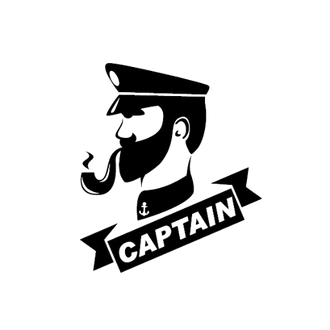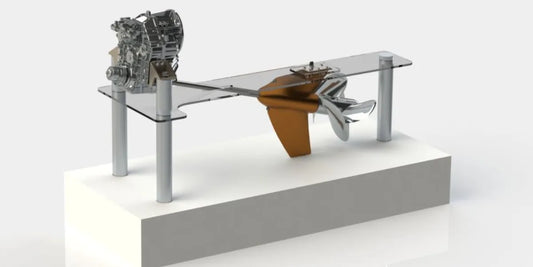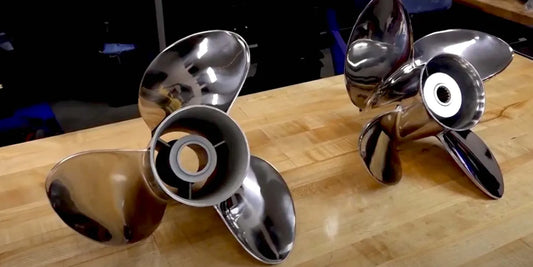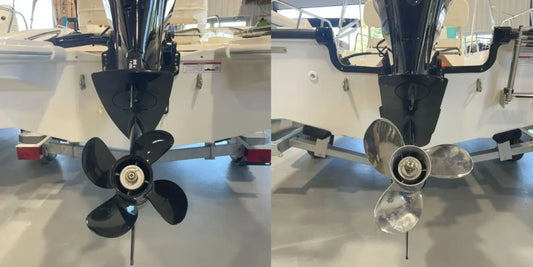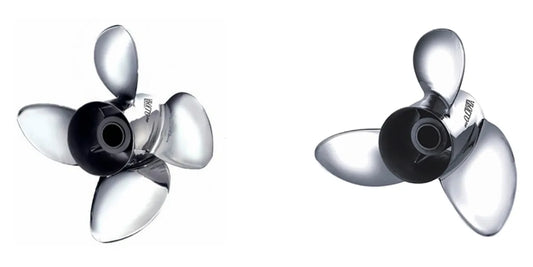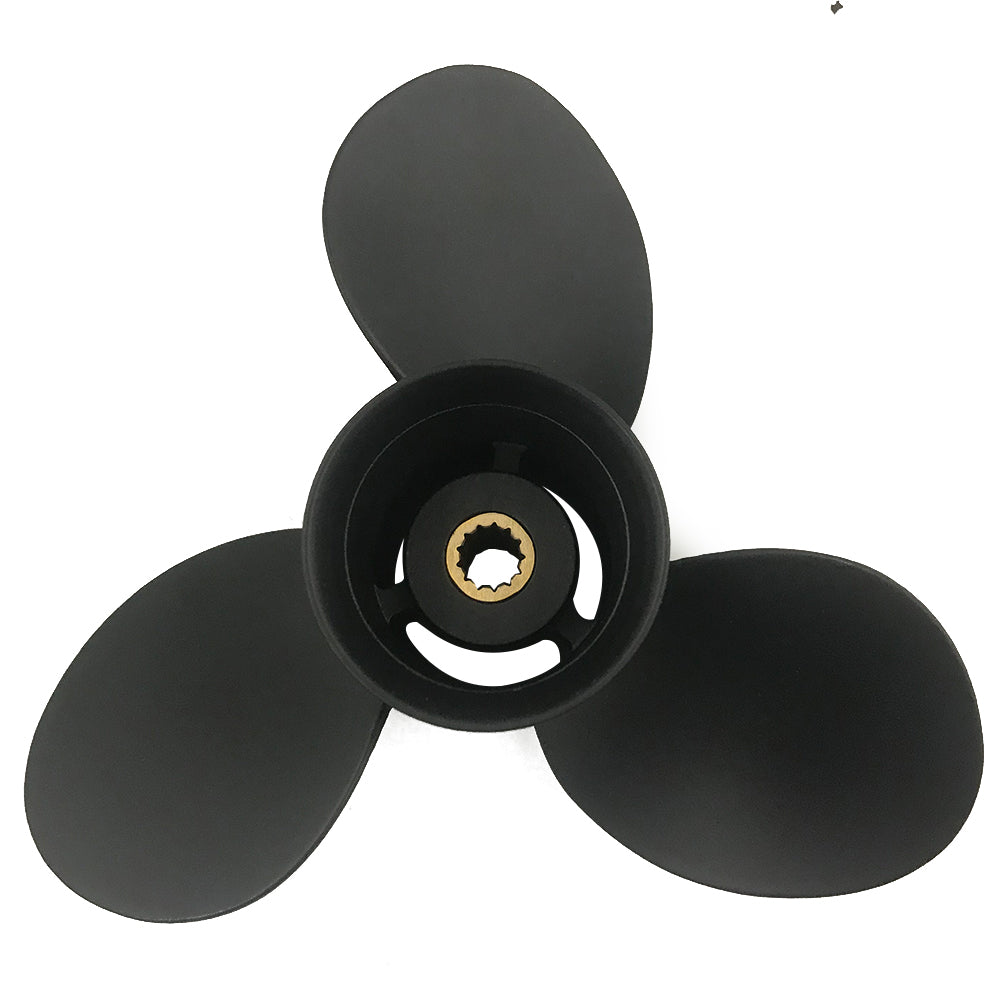When talking about the optimization of performance for a boat, few components can be as critical as the propeller. The choice of propeller is a big factor while converting engine power to thrust, affecting the speed, fuel consumption, and how the vessel responds to steering inputs. With so many options in the market, how do you know the right one for your boat? This guide will take you through the broad considerations and factors in selecting the correct propeller for your boat. We shall give you the know-how about pitch, diameter, materials, and blade configurations, enabling you to make an informed choice and enhance your time on the water.
How Do I Select the Right Propeller for My Boat?

Understanding Propeller Pitch and Diameter
Propeller pitch and diameter are two crucial aspects that directly affect performance on the water. The diameter refers to the distance across the circle that the propeller covers when completing one full rotation. Usually, larger diameters are set for slower boats needing greater thrust, such as pontoons or heavy workboats. Conversely, a small diameter allows faster vessels by creating less drag.
Alternatively, pitch refers to the distance a propeller would move in one revolution, practically through the water, assuming no slippage is involved. A high-pitch prop lets the boat attain larger speeds with less thrust and acceleration. It's best for light and fast boats. Lower-pitch propellers give higher thrust and accelerate quicker; hence, they are suitable for heavy loads or towing.
To maximize fuel efficiency, a good balance between the two factors is essential. For example, having a propeller diameter and pitch that fit your engine power and the boat's intended use can lead to better handling and performance during acceleration while being less stressful on the engine. Always check the engine manufacturers' recommendations to be sure the engine fits your application and will run efficiently.
Choosing Between Aluminum and Stainless Steel Options
When choosing between aluminum and stainless steel propellers, it is important to understand their unique characteristics and applications. Aluminum propellers are lightweight, less costly, and commonly used for recreational boat activities. They offer good performance and are easy to repair; they are best suited for boats with lower horsepower engines or for casual use in calm waters. However, considering their soft composition, they might wear out and lose efficiency if subjected to rough conditions or debris.
On the other hand, stainless steel propellers are well known for their durability, strength, and performance. Suitable for high-performance applications, stainless steel propellers will not flex much due to rigidity, providing consistent engine power transfer. Stainless steel propellers also resist damage from impacts and corrosion better than aluminum, making them more suitable for vessels operating in rougher environments where speed and precision matter. Stainless steel propellers are more costly than aluminum ones, but they may be worth the investment considering their enhanced performance and longevity.
To arrive at the best choice, consider the boating environments you frequent, the type of engine you use, and your performance expectations. For instance, an aluminum propeller could be the cost-effective choice for a recreational boater, whereas a stainless steel propeller is more suitable for a professional or someone seeking performance.
How Does RPM Affect Prop Selection?
Revolutions per minute (RPM) are also essential variables when selecting the desired propeller for your boat. As recommended by the manufacturer, every engine has a specific RPM range it should operate in to perform optimally and remain in good working condition for the longest time. This RPM range needs to be correctly maintained, so the propeller selection should include holding an engine within this range since it is directly related to acceleration, speed, and fuel economy.
In the case of a pitch that is too low or too high for a prop, the engine can be forced out of its ideal RPM range. To illustrate, a high-pitch prop might drop the RPMs and overload the engine, resulting in poor performance and long-term damage. Conversely, a low-pitch prop will increase the RPMs, strain the engine, and increase fuel consumption. Matching your prop to the recommended RPM range will enhance performance and protect your investment in the long run.
What Are the Propeller Options Available for My Marine Engine?

A Closer Look at Mercury Marine Propellers
As an authoritative brand in the boating industry, Mercury Marine boasts a rich and diverse line of propellers catering to different kinds of marine engines and applications. Different propeller options are available for recreational boating, water sports, and fishing, to name a few. They are precision-engineered systems produced with some of the finest materials, including stainless steel and aluminum, for durability and high performance.
These features may include corrosion-resistant finishes and a new generation of blade geometry with fine-tuned cavitation control to make the prop very efficient for water applications. For example, the Mercury Fury series is best-performing for top speed and acceleration and is designed for tournament anglers. In contrast, the Enertia series is designed with fuel efficiency and medium-range performance in mind. In short, by offering an extensive array of models, Mercury propellers cater to all boaters who crave classy cruising or all-out speed.
Mercury has always been at the forefront of innovation, and its newest technologies, such as the Flo-Torq hub systems, help reduce vibrations and allow easier interchanges between different engines for the ease of maintenance and upgrades. According to your engine and boating requirements, a properly chosen Mercury Marine propeller will give you the best trade-off between power, speed, and efficiency for an unforgettable marine experience.
Using a Propeller Selector Tool to Find the Best Fit
Selecting the ideal propeller for a boat is quite an activity. Still, the procedure becomes simpler when one can use a propeller selector tool to obtain recommendations tailored to their boating needs. Such tools take into consideration different aspects: type of engine, size of boat, weight, activities that will be conducted, and certain types of performance one might prefer- speed, efficiency, or load. By inputting the data, users receive an accurate and valid list of propellers that could best enhance the performance of their boat. This saves time and the concern of wasting money on a prop that goes against the vessel type or the boating purpose.
The present-day propeller selector tools arrive with detailed descriptions and specifications for every recommendation so boaters can compare the pitch, diameter, material composition, and blade design. Furthermore, some tools will incorporate functionality such as fuel efficiency, performance graphs, and environmental compatibility guides for when you are at freshwater lakes or in the open splendor of the sea. This kind of real-time support equips users to make decisions that ramp up performance and minimize any trial-and-error errors.
For the best application of a propeller selector tool, having your boat's measured specifications and operational data available (engine horsepower, RPM range, and current propeller details if any) will be an added factor; this followed by what the tool charts would consist of would form an integral selection procedure to elevate the boating experience, smooth rides, and fuel economy while achieving speed and handling characteristics.
How Can I Match My Current Propeller for a Replacement?

Identifying the Part Number and Stamp on Your Current Propeller
Begin by checking the propeller for part numbers and any stamps. Most propellers have essential details imprinted on the hub. This includes diameters and pitch displayed in a way such as "14x19," with the first number indicating the diameter and the second indicating the pitch. You may also find the manufacturer's name or logo and a part number specific to that propeller model. This information is crucial to locating a replacement.
By ensuring that the details you acquire match your engine's specifications and meet your boating operations requirements, you can confidently choose a propeller that will improve performance while providing the highest durability and efficiency.
Finding the Right Rake and Blade Design
The rake and blade designs of a propeller differ significantly, and their effects vary depending on individual boat situations and needs. The rake is the angle at which the propeller blades sit relative to the hub and significantly affects thrust generation and handling. A more pronounced rake, for fast vessels, lifts the boat's bow, lowering drag and increasing efficiency. On the other hand, a lower rake is most suitable and is used for boats that need to be more stable and able to accelerate; these include workboats or recreational craft.
Blade design, which refers to the shape, size, and number of blades, maximizes the rake's purpose to generate impressive performance. For example, three-blade propellers, thus gaining more speed, have less resistance to rotation, while those with four or five blades give smooth performance with better grip, especially in rough water or heavy-laden conditions. Alternatively, cupped blade edges can enhance thrust and minimize ventilation in chop, ensuring steady drive.
Selecting the combination of rake and blade design suitable for your boat, engine, and application requires conscious evaluation. Whether your concern is speed, fuel savings, or control, understanding these factors will enable you to select a propeller that offers the best performance without compromising on dependability.
What Factors Should I Consider for a Replacement or Upgrade of My Propeller?

How Horsepower and Thrust Impact Performance
Horsepower and thrust spotlight a boat's operating performance. Horsepower refers to an engine's power, which determines what acceleration might be possible, whether it can hold a particular speed better, or cope with loads. Usually, the greater the horsepower of an engine, the better the boat can run against resistance in harsher conditions such as strong currents and high winds.
Propellers generate force to propel a craft through water. Thrust efficiency depends on several factors: the design of the propeller, the pitch, and the state of the engine and hull of the boat. Ideally, maximum thrust will be optimized for boating activities such as towing, cruising, or fishing, guaranteeing smooth control and good fuel efficiency.
For example, speedboats need high horsepower, while towing skiers or hauling heavy loads may require enhanced thrust to balance control. These must be appropriately matched to the size and weight of your boat. Overloaded engines or underestimated thrust requirements will yield inefficient operations, consume excessive fuel, and might even induce wear and tear on the boat houses over time.
The Role of Top End Speed and Efficiency in Prop Choice
Top-end speed and efficiency are paramount considerations for the perfectly chosen propeller. The propeller's pitch primarily determines a boat's top speed. The higher the pitch, the faster it will move on open waters, but it may lose some acceleration and low-speed handling. A lower-pitch propeller will give quicker acceleration and better capabilities when towing, but will tend to limit maximum speed.
Efficiency is also connected to fuel consumption and performance. A correctly designed propeller allows an engine to perform at its rated RPM and prevents it from performing below or above that point. Proper balance reduces fuel consumption, extends engine life, and ensures constant thrust in varying conditions. Blade material, shape, and number of blades also matter. Stainless steel blade propellers are stern and deliver excellent performance at high speeds, while aluminum ones are cheaper and suitable for medium-duty applications.
Gathering test data under actual conditions, including load changes and water turbulence, plus engine output, makes an informed decision easier. With this knowledge, any owner can pick a propeller that covers the aspects of velocity and efficiency and guarantees smooth, fuel-efficient operations for their requirements.
Balancing Fuel Efficiency with WOT Considerations
One thing I have found to be of prime importance in setting fuel efficiency against WOT considerations is attaining the best possible compromise between performance and practicality. WOT testing is paramount since it provides information that helps assess whether my boat engine runs full throttle at the manufacturer's recommended RPM range. Because the engine can work full-throttle outside the recommended range, it will adversely affect its long-term performance and feasibility. Having that in view, I choose propellers and tune the engine to work optimally under WOT to ensure efficiency and durability.
Fuel efficiency is, however, a big issue for me because it dictates the running costs and its impact on the environment. In evaluating the fuel consumption of my boat at different speeds and loads, I can set the most economical cruising speed without regard to practical performance. Weight distribution, propeller slip, and hull condition are parameters I continuously monitor to improve efficiency during everyday use. From what I've learned, balancing these priorities requires data: WOT tests provide the performance baseline, and then careful observation, alongside necessary tweaks during everyday operations, address fuel efficiency.
By keeping an eye on these matters, I have satisfactorily met my needs. Whether cruising or pushing the engine to the limit, I am confident about my setup for best performance and fuel economy. This balance guarantees a dependable, smooth, and economically cost-friendly boating experience that caters to how I actually engage with my boat.
Installation Tips: How to Properly Install a Boat Propeller?

Step-by-Step Guide for Outboard Propeller Installation
Properly installing a boat propeller is essential to securing the best performance, safety, and life. Follow these steps carefully to install your outboard propeller:
Prepare Your Tools and Workspace: Gather the necessary tools, such as a socket wrench or spanner, marine grease, a washer, a cotter pin (if applicable), and a clean cloth. Work on a firm surface, or if the boat is still afloat, add extra precautions while handling tools or parts to avoid dropping anything.
Inspect the Propeller and Shaft: Before installation, check for damage, dust, or dirt on the propeller and shaft. Wipe the shaft clean with a cloth, ensuring all old grease is removed and the shaft is free of rust or scratches. A clean and smooth surface aids in reducing abrasion over time.
Grease the Shaft: Apply a skinny layer of marine-grade grease on the propeller shaft. Less grease lessens friction, prevents corrosion, and most importantly, helps with any future propeller removal. Avoid going overboard with the grease, as it may attract dirt.
Fit the Propeller and Key: Set up the propeller on the shaft so that the key—a small rectangular metallic member—fits appropriately into the keyway. The key locks the propeller and stops it from freely rotating on the shaft.
Fit Washer and Nut: Put the washer on the shaft, then fit the propeller nut on. Tighten the nut with a socket wrench, observing the torque values specified in your outboard motor's instruction manual. Do not overtighten, as that can damage the threads and, subsequently, the propeller hub.
Secure It with Cotter Pin or Locking Mechanism: If using cotter pins, insert the pin into the hole on the shaft and bend the ends back. If the mechanism is different, follow the instructions on securing it as provided by the manufacturer.
Check the Installation: Rotate the propeller with your hand, ensuring it moves smoothly without wobbling or resistance. Ensure there are no loose parts and everything is tightly fastened.
Test Run Your Outboard: After installation and fitting, conduct a slow test run on the water to confirm the propeller's efficiency and balance. Listen for rough noises or vibrations that can indicate that the installation has been done incorrectly.
Following these steps ensures that your outboard propeller runs well and increases its life. Regular checks and maintenance, paired with diligent installation, will make your boating experience as smooth as possible.
Common Mistakes and How to Avoid Them During Prop Installation
One of the usual mistakes I have noted while installing props is that people fail to clean their propeller shafts before installation. Dirt, debris, and old lubricant can prevent the propeller's proper setting, leading to challenges like wobbling or premature wearing. I never fail to clean the shaft using a clean cloth and apply a fresh coat of marine-grade grease before the propeller goes on. This ensures a smooth rotation and guards against corrosion.
Another frequent issue is that some people tighten or loosen the prop nut either excessively or inadequately. These situations are both problems: if you overtighten it, you might damage the threads or the prop hub; if you undertighten it, the propeller could loosen and fall during operation. So I use a torque wrench. I tighten the nut to the correct specification, as recommended by the manufacturer. In cases where a cotter pin or locking mechanism is applicable, its use offers additional protection.
Another common oversight is failing to do a final inspection. From my perspective, it's important to double-check that everything—washers, spacers, locking devices—is installed correctly. That quick check-up can save me from bigger problems on the water they'll ever experience. By following through on this detail and taking my time, I can ensure that the prop installation is always strong and capable.
Reference Sources
-
How to Choose the Right Prop for Your Boat - BoatUS - A detailed guide on selecting the best propeller for optimal performance.
-
Choosing the Correct Boat Propeller—Crowley Marine explains how to match propeller pitch and engine RPM for efficiency.
-
Boat Propeller Fit Guide - Go2Marine - Offers insights into selecting the right propeller for your specific needs.
-
Prop Selector: Find the One for Your Boat - Mercury Marine - A tool to help identify the best propellers for various marine engines.
-
Prop Wizard—Turning Point Propellers is an interactive tool for finding the ideal propeller based on your boat's specifications.
Frequently Asked Questions (FAQs)
Q: What items should I look for to give me the best prop for my boat?
A: First, consider your motor's HP rating; second, what prop do you presently have? Third, the number of blades of the prop; fourth, the material, aluminum propellers, for example; and fifth, the usage of your boat. These specifications will lead you to finding the best props for your outboards.
Q: How can I be sure my present prop fits my boat?
A: When checking on your present prop, the vendor will want to know details such as pitch, diameter, number of blades, and material. There are also boating forums where you can get recommendations. Sometimes, one has to install a different pitch or change the prop to work through a performance issue.
Q: What is pitch's relevance in a prop, and how does it affect my boat's performance?
A: Pitch is the forward movement of the propeller in inches in one revolution. If you want maximum speed for high pitch means less torque and thus less acceleration by your boat. It is quite the opposite; a higher pitch can reduce your ability to accelerate. For your use, the best compromise needs to be sought.
Q: Possible to increase the pitch on my current props for better performance?
A: Yes, you can modify the pitch of the prop you own if it is a prop model manufactured for pitch adjustment. However, it is best to have this done through your dealer to ensure that the pitch is adjusted for a performance issue and safely corrected.
Q: What number of blades should I go with for a propeller?
A: The number of blades will contribute to how a propeller performs. More blades give better torque and handling, so they're great for towing or trailing. Fewer blades mean it could go faster. Think about what you need it for concerning your boat.
Q: How can I find the prop best suits my boat specifications?
A: To find the best props, you should check the manufacturer's recommendations and compare the shaft size and rotation specifications, etc. You might also want to check some boating forums for input from other boaters who have experience with various types of propeller models.
Q: What performance issues related to propellers should I look out for?
A: Some common problems could be slow acceleration, excessive RPM, and trouble maintaining speed. If your problem points to these, then your current prop should be replaced or pitch adjusted according to your best interests in improving the boat's performance.
